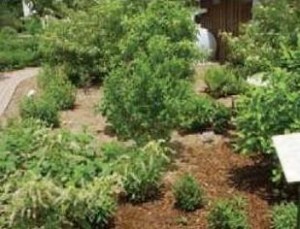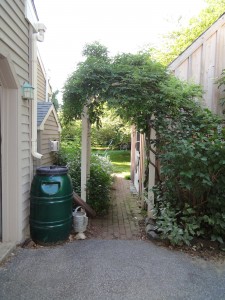We have talked about rainwater harvesting for watering the garden or even for flushing the toilets with the end goals of saving money on utilities and conserving domestic drinking. Why else would we want to capture rainwater? Water quality. Reducing the volume, the velocity and the flow of rainwater (aka stormwater) reduces pressure on our streams, helps ensure adequate groundwater recharge, reduces non-point source water pollution and increases water quality for aquatic life and for domestic drinking.
Rainwater: Waste or Asset?
In the past, rainwater management was all about quantity – it was management of where the water went – conveying it to a disposal site to get rid of it without harming buildings and roads. Water quantity design uses grading, pipes, swales and berms to channel the flow to storm drains and on into the stream system.
Water management is evolving from this waste disposal focus to looking at rainwater as an asset. This evolution to a water quality management focus looks at quantity AND quality issues in creating solutions that seek to retain rainwater on the site where it was generated to allow the water to naturally infiltrate into the groundwater and the aquifers.
Numerous innovative stormwater management techniques called BMP’s (Best Management Practices) have been developed to aid engineers and designers in developing site specific rainwater solutions that emphasize the recharge of groundwater and water balance.
Passive versus Active Rainwater Capture
Rainwater is certainly active as it falls from the sky – sometimes too active. It can also be very active when it lands and flows or sheets across parking lots, driveways, lawns and sometimes, unfortunately, basement floors. Active rainwater capture refers to harvesting the water in a vessel of some sort for a purpose. Passive rainwater capture uses techniques to slow down and hold the water allowing it to infiltrate or seep into the ground.
This infiltration allows the underground water systems to balance the water you take out of the aquifer every day to shower, drink and wash, with water you slowly add in via your passive rainwater capture system. That balancing doesn’t happen when rainwater is scooted away to the stormwater system. Once there it never stops till it gets to the ocean and your aquifer, your drinking water source, just gets depleted. It does get recharged a bit but not in balance with the withdrawls.
What’s Non-Point Source Pollution?
Non-point Source Pollution or NPS can’t be tracked to a single source such as an industrial discharge pipe. Rather it occurs when stormwater from rain or snowmelt washes over the land collecting pollutants such as fertilizers, pesticides, trash, unprotected soil and oil. If you have a stream on or near your property these pollutants may flow directly into that waterway – otherwise the mixture flows to storm drains that eventually discharge to a river or a stream and then on to the ocean.
NPS pollution affects you directly if your home uses public water because it drives the cost of treating the water for human consumption. In my area, many of the water companies draw their drinking water directly from area rivers and streams. The City of Philadelphia draws much of its water from the Delaware River and the City of Wilmington, DE draws its water from the Brandywine Creek.
If you use well water, NPS affects you as pollutants leach into the soil and your groundwater.
NPS pollution degrades water quality by increasing refuse, decreasing the water’s oxygen levels and increasing toxin levels. This affects the overall health and viability of fresh and marine ecosystems – impacting on fish, wildlife and you as you swim in and enjoy the water.
What Can I Do?
If you are building a new home or office, talk with your design and construction team about incorporating passive and active rainwater systems into your project. If you have an existing property and are contemplating regarding or some other dramatic rainwater capture system please consult with an engineering firm or rainwater specialist. But there are some techniques and BMP’s you can put into place right now:
Adjust Your Downspouts
- Direct downspouts away from paved structures and run them out onto your lawn
- No lawn? Consider installing rain barrels at every downspout and then either use the water to irrigate or let it slowly drip out.
- Even if you have a lawn, install rain barrels at as many downspouts as possible.
Stop Adding Pollutants to the Mix
- Indigenous or native plants require little to no fertilization. Rather than add fertilizer, enriching with compost, that may be all your plants will need. You might want to try mulching your grass clippings and composting your fall leaves so that you can add nutrient rich soil amendments next year and avoid increasing the waste stream.
- Don’t use pesticides at all. Rather rely on predator insects like Praying Mantis and beneficial insects such as Lady Bugs to manage insect problems.
- Don’t fertilize your lawn. You will be surprised how little fertilizer a lawn requires and how much money you will save! Experiment with different types of seed to see what works best. If you must fertilize, use organic fertilizers that release nutrients more slowly and don’t fertilize before a rainstorm.
- Wash your car at the car wash – not in the driveway
- Never dump anything down storm drains or in streams
- If you have septic, have the tank pumped and the system inspected regularly
Adjust Your Landscaping
- Plants do a wonderful job of controlling NPS pollution because they slow and/or stop rainwater run-off allowing the water and its accompanying pollutants to slowly leach into the soil. This slowing is especially important on a slope.
- Many plants help to take up pollutants and act as soil cleaners. In fact, studies show that some trees and grasses can actually remediate hazardous soils! I am not suggesting that you need hazmat remediation but I am suggesting that your lawn can do a pretty good job if given time.
- Vegetate any bare spots you may have in your yard to avoid soil erosion.
- Add winding paths to increase water infiltration by slowing velocity and directing the water into the planting beds.
 Add a rain garden (if you want to sound really scientific, call it a bioretention basin) to capture runoff. This is a great solution for anyone with a little space – not necessarily a lot of space.
Add a rain garden (if you want to sound really scientific, call it a bioretention basin) to capture runoff. This is a great solution for anyone with a little space – not necessarily a lot of space.- If you are luck enough to have a stream or pond on your property, establish a no mow zone along the edge and plant a buffer strip of grasses and shrub’s in the lawns place. This will trap excess fertilizers and sediment before they enter the water.
You may say that your property is too small to do any of this. To you I say, HA! I was at GreenBuild a couple of years ago listening to a lecture by Marcus de la Fleuran Illinois architect who had a small landscape where he retained all of his stormwater. I am not suggesting that you have to go to all of the lengths that are shown in his link but it does provide food for thought about what you can do – right now – to protect those downstream from you.

